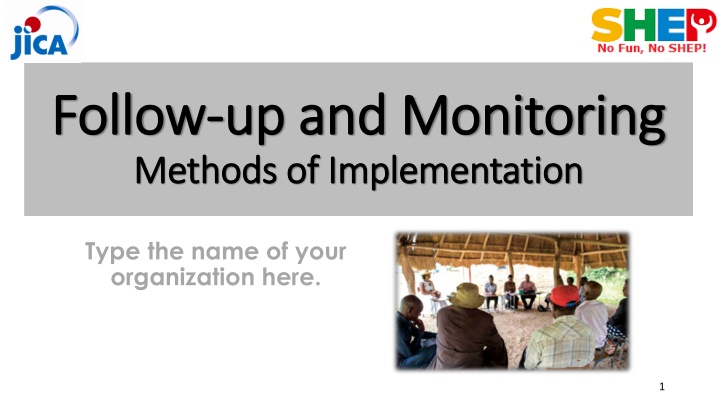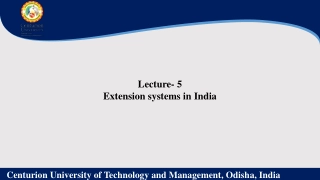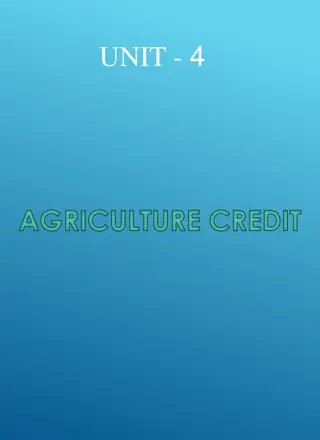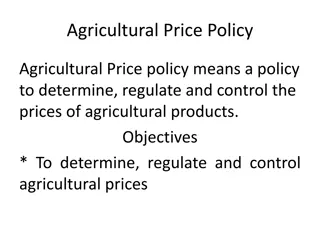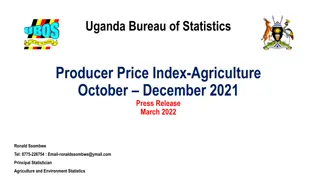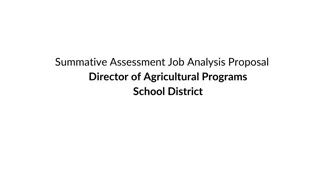Effective Follow-up and Monitoring Strategies for Agricultural Programs
Implementing effective follow-up and monitoring methods is crucial in ensuring farmers apply taught techniques and knowledge in their practices. This involves activities such as sensitization workshops, stakeholder forums, market surveys, and in-field trainings. The process includes periodic visits to assess progress, implementing endline surveys for comparison, and tracking changes made by farmers. Overall, the aim is to enhance learning retention and evaluate the impact of agricultural interventions.
Uploaded on Oct 08, 2024 | 1 Views
Download Presentation

Please find below an Image/Link to download the presentation.
The content on the website is provided AS IS for your information and personal use only. It may not be sold, licensed, or shared on other websites without obtaining consent from the author.If you encounter any issues during the download, it is possible that the publisher has removed the file from their server.
You are allowed to download the files provided on this website for personal or commercial use, subject to the condition that they are used lawfully. All files are the property of their respective owners.
The content on the website is provided AS IS for your information and personal use only. It may not be sold, licensed, or shared on other websites without obtaining consent from the author.
E N D
Presentation Transcript
Follow Follow- -up and Monitoring up and Monitoring Methods of Implementation Methods of Implementation Type the name of your organization here. 1
WHERE ARE WE?: WHERE ARE WE?: Follow Follow- -up and Monitoring up and Monitoring in SHEP s 4 Steps SHEP s 4 Steps in 4 Steps Activities 1. Share goal with farmers. Sensitization Workshop Participatory Baseline Survey (optional) Stakeholder Forum Market Survey Target Crop Selection Crop Calendar Making 2. Farmers awareness is raised. 3 . Farmers make decisions. 4. Farmers acquire skills. In-field trainings Follow-up and monitoring (including Participatory Endline Survey) Follow-up and Monitoring are when the farmers review what they have learned and achieved. 2
PART 1: CONCEPT PART 1: CONCEPT 3
WHY?: WHY?: Objectives of Objectives of Monitoring Monitoring and and Follow Follow- -up up Aims at ensuring farmers actual application of taught techniques and knowledge. Not only look at farmers production practices but also assess their progress of marketing and other collective work as a group. Follow-up and Monitoring ensures that the farmers learning during the SHEP trainings truly sticks in their minds. 4
WHAT?: WHAT?: Outline of Monitoring and Follow Outline of Monitoring and Follow- -up Periodically visit farmers to ensure they are applying the knowledge they have learned. Monitor the progress of activities described in the groups Crop Calendars. Participatory Endline Survey is conducted using almost the same survey formats as the Participatory Baseline Survey. The Endline Survey data is analyzed for the purpose of comparison with the results of the Baseline Survey. up 5
FORMAT: FORMAT: Endline Survey Questionnaire Forms Endline Survey Questionnaire Forms Endline Survey Part 1- Production, Income and Cost The same form as Baseline Survey Form except for the columns where the farmers are asked to write information on what changes they have made after SHEP 6
FORMAT: FORMAT: Endline Survey Questionnaire Forms Endline Survey Questionnaire Forms Endline Survey Part 2- Agricultural Techniques The same form as Baseline Survey Form except for the columns where the farmers are asked to write information on what changes they have made after SHEP 7
HOW?: HOW?: Key Follow-up and Monitoring visits should help the farmer group take off to become self-reliant farmers who can practice market-orient agriculture on their own initiatives. Raising Motivation Key I Implementation Tips mplementation Tips The Participatory Endline Survey should give the farmers opportunities to confirm how much they have improved through their experience in participating in SHEP. Raising Motivation 8
PART 2 PART 2: PRACTICE : PRACTICE 9
STEP: STEP: Implementation Procedures Implementation Procedures 1. Visit the farmer groups periodically to give advice and monitor the progress of activity implementation. 2. Refer to the results of Baseline Survey Part 2- Agricultural Techniques and judge how much improvement the farmers have been making in terms of adoption of techniques. Provide support as needed. 3. Refer to the Crop Calendars and monitor the progress of activity implementation. Provide consultation where necessary. 10
STEP: STEP: Implementation Procedures Implementation Procedures 4. Collect qualitative information on gender, i.e. success stories, to see how gender equality and women s empowerment have contributed to attaining the groups goal. 5. Undertake the Participatory Endline Survey using two types of formats. 6. Submit the completed forms to the designated office (Change this to an appropriate section -e.g. Project Unit, central ministry office, etc. where analysis will be made) Give feedback to the farmers when analyzed data is sent back to the extension staff. 11
Completing Production, Income & Cost Sheet Completing Production, Income & Cost Sheet Basic information of the farmer Production, income & cost Unit conversion Changes after SHEP 12
Completing Production, Income & Cost Sheet Completing Production, Income & Cost Sheet 1 Crop Name and Variety Indicate name of the horticultural crop and variety grown in the last cropping season. 2 (2a. & 2b.) Area under the Crop in meter X meter (m2) or ha Pacing can be used to estimate area under the crop 13
Completing Production, Income & Cost Sheet Completing Production, Income & Cost Sheet 3 Production sold at market in various unit (e.g. bags, crates, bundles, bushels, etc.) Total quantity sold at markets. 4 [Automatic calculation- no need to write in this column as long as conversion is indicated] Production sold at market in kg Farmers can write in kg in this column instead of writing in column 3. 14
Completing Production, Income & Cost Sheet Completing Production, Income & Cost Sheet 5 (4/2b.) [Automatic calculation- no need to write in this column] Production sold at market in kg per ha Analyzing productivity. Farmers do not need to write in this column. 6 Average Price per various unit (local currency per unit) Marketed price per unit 15
Completing Production, Income & Cost Sheet Completing Production, Income & Cost Sheet 7 (6/unit conversion in box) [Automatic calculation- no need to write in this column] Average Price per kg in local currency Farmers do not need to write in this column if they do not know the price per kg. 8 (3X6) or (4X7) [Automatic calculation- no need to write in this column] Total Income in local currency This is the total income from the crop. 16
Completing Production, Income & Cost Sheet Completing Production, Income & Cost Sheet 9 Total Cost of Production in local currency Cost of seed, planting materials, fertilizers/manures, pesticides, posts/stakes, labor costs, transportation & marketing costs,etc. 10 (8-9) [Automatic calculation- no need to write in this column] Net income (profit) in local currency This is the total profit from the crop. 17
Completing Production, Income & Cost Sheet Completing Production, Income & Cost Sheet In the box, indicate unit conversions <example> 1 bag of Irish Potato 110kg 1 head of cabbage = 2kg 1 crate of tomatoes = 20kg A conversion table like this will be useful. 18
Completing Production, Income & Cost Sheet Completing Production, Income & Cost Sheet In the box, list various changes the farmers have made after SHEP. Collect information on their changes in production, marketing and collective work as a group. <Example> I started producing a variety of tomatoes, Cal J, which the market prefers. I started to arrange transportation with my group members to reduce the transportation cost. 19
Completing Agricultural Techniques Sheet Completing Agricultural Techniques Sheet Basic information of the farmer Questions to assess farmer s agricultural techniques 20
Completing Agricultural Techniques Sheet Completing Agricultural Techniques Sheet If the answer is Yes , simply check ( ) the left box marked Yes . If the answer is No , simply check ( ) the left box marked No . We expect that the number of Yes is more than that of the Baseline Survey result. Discuss the techniques which had many No answers with the farmers to see if they have any difficulties adopting such techniques. 21
Completing Agricultural Techniques Sheet Completing Agricultural Techniques Sheet Changes after SHEP In the box, list various changes the farmers have made after SHEP. <example> I started making compost. I changed from broadcasting to row planting. Collect information on their changes in techniques 22
CHECKLIST: CHECKLIST: Points to be Confirmed after Points to be Confirmed after Monitoring and Follow Monitoring and Follow- -up The target farmers understand their strengths and weaknesses and are given specific guidance and advice to further improvement. The target farmers understand when and how they can graduate from SHEP. The target farmers are committed to continue adopting the production and marketing techniques in the future. The male-female ratio of the participants is balanced. Quality of participation of male and female members is reviewed. Gender-disaggregated data is collected and analyzed. Changes in gender roles between husband wife are reviewed. Changes in decision-making between husband and wife are reviewed. up 23
Monitoring Monitoring and and Follow Follow- -up up in Action in Action 24
TROUBLESHOOTING TROUBLESHOOTING What if the farmers become demotivated due to a crop failure? SHEP supports farmers psychological needs for autonomy. Through their SHEP experience, the farmers feel they own the whole process of planning, decision-making, and risk-taking. Therefore, they do not easily become demotivated. What if the farmers do not adopt production techniques sufficiently? Process and required time for individual farmers to adopt new techniques vary. Sharing success stories and best practices with the farmers can be effective to encourage them to adopt new skills. 25
TROUBLESHOOTING TROUBLESHOOTING The farmer groups became disintegrated. What should we do about it? Try to probe what went wrong at what point. It is important for the farmers to understand that securing a volume of produce is an essential factor for small-scale farmers to increase profitability of farming business. Reconsider the group membership if it feels absolutely necessary to reorganize the group. 26
Way Way Forward Forward: : Implementation Schedule, Implementation Schedule, Reporting, Reporting, add any other necessary info. here add any other necessary info. here 27
